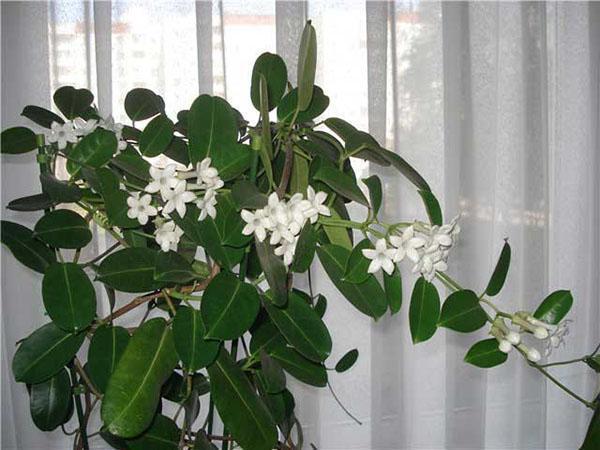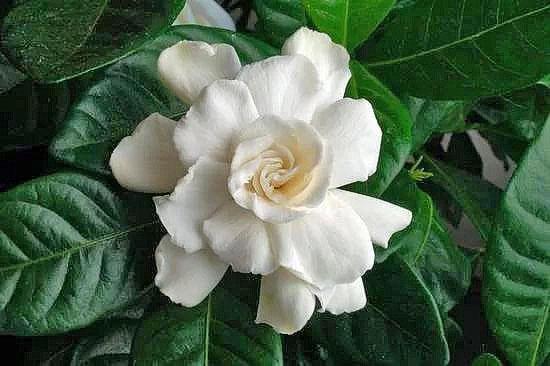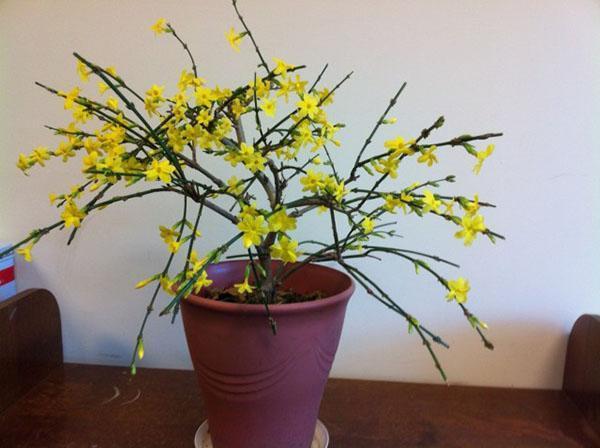Description of the features of indoor jasmine varieties
 Jasmine belongs to evergreen climbing or upright shrubs. The leaves have a simple trifoliate or pinnate configuration.
Jasmine belongs to evergreen climbing or upright shrubs. The leaves have a simple trifoliate or pinnate configuration.
The flower has a large regular shape, collected in shields. It can be umbellate or single, apical or lateral. The flower corolla is white, yellow, reddish in color.
Flower varieties
Jasmine has over 200 species, many of which are grown at home or in greenhouses. Let's get acquainted with some of them in more detail.
Jasmine large-flowered

As you can see in the photo, white flowers of large-flowered jasmine are arranged umbrella-shaped up to 10 pieces at a time. They are concentrated at the top of the shoot. They are large in size and have a strong aroma. Jasmine shrub (see photo) refers to long-flowering plants. Abundant flowering lasts from June to October.
The flowers of the plant are essential oil. They are actively used to add aroma to different types of tea.
Jasmine
 Holo-flowered jasmine belongs to weakly branching shrubs. It has long shoots with a few small leaves of rich green color. They have a triple shape. In winter, most of the leaves fall.
Holo-flowered jasmine belongs to weakly branching shrubs. It has long shoots with a few small leaves of rich green color. They have a triple shape. In winter, most of the leaves fall.
The flowers of the jasmine are egg-yellow in color. They are quite large in size. They are located in the axils of the leaves along the entire length of the stem.
Jasmine blooms from January to April. Due to this, this variety is called winter.
Jasmine Sambac
 This variety belongs to the most unpretentious representatives of jasmine. The native land of the plant is tropical Asia, traditionally grown in Indonesia.
This variety belongs to the most unpretentious representatives of jasmine. The native land of the plant is tropical Asia, traditionally grown in Indonesia.
The plant is a liana, the length of which reaches 6 m. The shoots are pubescent, rather thin. Sambac jasmine leaves are located opposite each other, have an ovoid shape: the base is rounded, while the top is pointed or obtuse.
Double or semi-double flowers are white in color. Flowers jasmine sambac photos are presented below. It shows that they are collected umbrella-shaped, 10 or more pieces at a time.
In their appearance, they more resemble camellia flowers or semi-double varieties of roses.
Indoor plant flowering begins in March and lasts until the end of October.
Sambac flowers have a strong pleasant scent. Due to this, they are used to give a unique aroma to tea.
Jasmine multiflorous
 In another way, multiflorous jasmine is called polyanthus.
In another way, multiflorous jasmine is called polyanthus.
The shrub is a climbing plant. The drooping branches actively grow in width. An adult plant can reach a height of 3 meters.
In multi-flowered jasmine, the stem, branches and leaves have a gray-green tint, which is acquired due to the fine hairs that cover them. The photo clearly shows that the jasmine flowers of this variety are arranged in clusters and have the shape of stars. They can be found both along the entire stem, and only at its top.
The plant continues to bloom throughout the year.When the flowers bloom, jasmine emits a strong, pleasant scent.
Jasmine madagascar
 Madagascar jasmine belongs to indoor lianas. It is not very popular in Russia, but it is common in the West and in the USA.
Madagascar jasmine belongs to indoor lianas. It is not very popular in Russia, but it is common in the West and in the USA.
The dark green leaves of the creeper are oval in shape. In length they reach 10 cm. As you can see in the photo, flowers collected in inflorescences have the shape of stars. They can be pure white or have a delicate creamy, yellowish or purple hue. They cover the entire stem of the plant. Madagascar jasmine has a pleasant aroma.
Liana secretes a caustic juice, which, if it gets on the skin or mucous membrane, causes irritation.
Liana can be grown both in the house and in the winter greenhouse. Blooms from June to August. But with proper care - observing the temperature regime, additional lighting - indoor jasmine continues to actively bloom in the winter.
Jasmine japanese
 Another view jasmine indoor - Japanese or primrose variety. Despite the name, the homeland of the flower is not Japan, but North China and the Caucasus. The plant belongs to the creeping varieties. Therefore, he needs support.
Another view jasmine indoor - Japanese or primrose variety. Despite the name, the homeland of the flower is not Japan, but North China and the Caucasus. The plant belongs to the creeping varieties. Therefore, he needs support.
Japanese jasmine has small flowers, reaching a length of 4 cm. The petals are yellow, round, in shape they resemble a primrose or yellow primrose. The flowers are odorless. The dark green leaves of the shrub have a dense structure. They are trifoliate in shape, rather elongated. Stems practically do not branch, bending during growth in an arc towards the bottom.
Japanese jasmine blooms from March to early June.
Jasmine Bissa
 The plant belongs to evergreen shrubs. Liana can reach a length of 2 m. Dark green leaves are lanceolate, located opposite each other. They can be up to 5 cm long. They have a light, almost invisible edge. Jasmine Biss flowers range in color from delicate to deep pink. They are located in whorls of 3 pieces at the top of the bush. Flowers can be up to 52 cm in diameter. They have a rich aroma. It does not bloom for long. Activity falls on May.
The plant belongs to evergreen shrubs. Liana can reach a length of 2 m. Dark green leaves are lanceolate, located opposite each other. They can be up to 5 cm long. They have a light, almost invisible edge. Jasmine Biss flowers range in color from delicate to deep pink. They are located in whorls of 3 pieces at the top of the bush. Flowers can be up to 52 cm in diameter. They have a rich aroma. It does not bloom for long. Activity falls on May.
 Jasmine is an amazing plant that delights with its active flowering, intoxicating scent. The flower is very popular among florists and is a true decoration of the flower garden. But it is worth remembering that if the plant is large enough and is in the room, it is better to take it out at night. The strong scent can cause headaches.
Jasmine is an amazing plant that delights with its active flowering, intoxicating scent. The flower is very popular among florists and is a true decoration of the flower garden. But it is worth remembering that if the plant is large enough and is in the room, it is better to take it out at night. The strong scent can cause headaches.